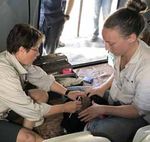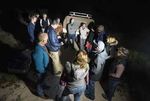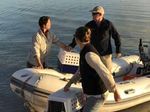WIRRUWANA NEWS UPDATESFROMDIRKHARTOGISLAND SUMMER2018 - SHARK BAY
←
→
Page content transcription
If your browser does not render page correctly, please read the page content below
Wirruwana news
UPDATES from Dirk Hartog Island summer 2018
Welcome to the first edition of Wirruwana News. Wirruwana is the Malgana Aboriginal name for Dirk Hartog
Island, a place that is once again becoming home to a suite of native animals through the Return to 1616
project.
Although this newsletter sharing what’s happening on Dirk Hartog Island is under the Return to 1616 project, it
also looks at other activities on the island and contributions to this biannual newsletter outside the project are
both welcome and appreciated.
Making history The acacia and spinifex sandplains on Dirk Hartog
A small group of hushed onlookers witnessed an Island are now lush with vegetation because there
historic event on Dirk Hartog Island on 29 August are no longer sheep and goats on the island. Nearly
2017 - the first release of native animals onto the all of the sheep were removed in the lead up to
island under the Return to 1616 project. the island becoming a national park in 2009. The
remaining sheep were removed along with goats
and cats during the first stage of the Return to 1616
project.
Twenty-four hare-wallabies were translocated from
Bernier and Dorre Islands Nature Reserve to Dirk
Hartog Island National Park. After taking a moment to The Dirk Hartog Island National Park Ecological
get their bearings, the wallabies slowly ventured into Restoration Project, Return to 1616, aims to restore
their new surroundings, some snacking on the now the island’s ecology to how Dirk Hartog would have
lush vegetation along the way. seen it in 1616.
Dirk Hartog was the first European to land on
Australian soil and leave evidence of doing so. On
25 October 1616 he left a pewter plate with details
of his journey to Indonesia. Since his visit, the island
has seen a succession of seafarers and enterprises,
including the devastating occupation of thousands of
sheep and goats.
Feral cats were also introduced and between the loss
of habitat and onslaught of new predators, at least 10
native species on the island became extinct.
The Return to 1616 project has removed goats
and last of the sheep and believes there are no
cats left on Dirk Hartog Island. This has allowed a
small translocation trial in August 2017 to refine the
DBCA officers Kelly Rayner and Keith Morris release the first
banded hare-wallabies (Lagostrophus faciatus) onto Dirk Hartog transport, release and monitoring protocols for future,
Island. large-scale translocations.
Contributors: DBCA officers Dr Saul Cowen, Research Scientist; Kelly Rayner, Technical Officer; Khayla Wordsworth,
Reserves Officer, and volunteers Claudia Buters and Andreas Stricker. Photos: Keith Morris, Saul Cowen, Claudia Buters,
Richard Manning, Sharon Drabsch. Editor: Susan Pedersen.
The Return to 1616 project is funded by the Gorgon Barrow Island Net Conservation Benefits Fund.Wirruwana news updates from Dirk Hartog Island SUMMER 2018
Journey of the hare-wallabies
Twelve banded hare-wallabies and 12 rufous hare-wallabies were captured over two nights on nearby Bernier and Dorre
islands, transferred via boat to Dirk Hartog Island, fitted with radio collars and released after dark the following day, 29
August 2017. All were released south of the cat-proof fence and initially they
stayed close to the release sites but, by the end of September, the wallabies
were regularly moving several kilometres a night.
The wallabies took full advantage of the
Cape Inscription tracks in place for the cat eradication
Turtle Bay program, and efforts to keep tabs on
Urchin wallabies kept staff and volunteers
Point Dampiers extremely busy.
The Landing
Block
Many a sand dune was climbed to get just
one ping from the radio collar of whichever
animal had made a big move the previous
night.
One particular rufous hare-wallaby
Withnell travelled more than 20km north to the cat
Point fence at Herald Bay. He then headed south
and, after a short sojourn at Notch Point,
was last found near Longtom Bay.
Mystery
Beach
Sandy
Point
Charlies Harbour Louisa
Bay
Quoin Head Above - DBCA officers Dr Colleen Sims and Kelly
Rayner taking delivery of hare-wallabies; conducting
health checks and fitting telemetry collars.
Take care
The wallabies tend to
f fence Herald Bay
Cat-pro
o use vehicle tracks to
get around so if you are
Quoin Bluff South
driving on the island,
please slow down and
watch out for them,
particularly between
Ranger report
Notch Point
dusk and dawn.
Many Dirk Hartog Island visitors
have met Shark Bay rangers on
Dirk Hartog
the island recently. During patrols
Island Lodge
the rangers have been working their
way through jobs ranging from sign
installations and risk management
inspections to toilet construction at
Urchin Point and The Block.
Blowholes
Longtom
Bay
Surf Point Sunday
Island Bay Left - Unloading a prefabricated toilet for transport
across the island.
Cape Ransonnet
Above - Loo with a view at Urchin Point.Wirruwana news updates from Dirk Hartog Island summer 2018
Surviving and thriving Turtle tagging
There was a small scare only two days after the release In January each year Shark Bay staff and volunteers
when one collar went into ‘mortality mode’, leading to a embark on a pilgrimage to survey loggerhead turtles at
body search. Turtle Bay on the northern end of Dirk Hartog Island.
The team tracked the collar’s signal and surrounded the This year 372 turtles were surveyed, 183 (49 percent)
bush emitting it. Suddenly, a very much alive banded hare- of which were recaptures. One of the turtles has been
wallaby burst out of the bush. The initial fright of the search surveyed at Turtle Bay seven times since 2003.
team was quickly followed by relief as the wallaby with a Local Malgana women took part in this year’s tagging
faulty collar raced for cover elsewhere. program, exchanging knowledge and experiences of the
There had only been one mortality when the monitoring island, its inhabitants and annual visitors.
team left the island early in December, a rufous hare-
wallaby. Twelve banded and 11 rufous hare-wallabies
were still alive and there were eight island-born young in
pouches getting ready to contribute to the population in
a few months time. This was an excellent outcome for a
translocation of medium sized mammals.
While some of the collars were removed due to signs of
neck rubbing, 18 animals were allowed to keep their shiny
hardware for the summer.
Radio-tracking flights on 19 December 2017 and 22
January 2018 found all these animals alive and seemingly
settled in favoured areas between Tetradon Loop and
Cape Ransonnet. Some also seem to have clustered,
suggesting social behaviour. Above - Measuring a loggerhead turtle.
There will be two more radio-tracking flights before the Left - Dr Saul Cowen radio tracking near Tetradon Loop.
research team returns between March and May 2018 Below - Kelly Rayner with volunteers Richard Variakojis, Auriah
Lane and Claudia Buters preparing for a radio-tracking session.
to remove collars and conduct final health and breeding
Trapping
checks.
A Global Gypsies tour group volunteered on Dirk Hartog
Island during October 2017.
Working with DBCA’s team, the Global Gypsies used pitfall
and other live-capture traps to catch small vertebrates.
The trapping was highly successful with four small
mammal species and 30 reptile species captured during 10
days of trapping. Good numbers of several species were
caught, which may indicate recovery of native fauna since
the removal of cats.
This was deemed a very successful trip by all concerned
and will hopefully be repeated in the future.
Teamwork
DBCA staff monitored the hare-wallaby populations
on Bernier and Dorre islands before undertaking the
mammoth tasks of capturing 24 animals, transporting
and releasing them on Dirk Hartog Island and intensively
monitoring them post-release.
Through all of this they were supported by Parks and
Wildlife Service staff in Shark Bay, the Midwest Region,
and other members of the Return to 1616 team. Support
also came from Kieran Wardle, his family and employees
at Dirk Hartog Island Eco Lodge, facilitating transport
and accommodation on the island.
The DBCA team is now preparing the 2018 works
program, including further hare-wallaby translocations.Wirruwana news updates from Dirk Hartog Island SUMMER 2018
Valuable vollies
Claudia Buters was on Dirk Hartog Island when the
wallabies arrived. Sunshine and dugongs accompanied
her and Dr Saul Cowen, the DBCA scientist leading the
translocation work, as the barge took them to Dirk Hartog
Island.
Although the arrival of the wallabies was delayed due to
bad weather, Claudia said there was plenty of work to do
while waiting. “Several days were spent finding innovative
ways to cover old pastoral wells surrounding the release
sites and preparing for the release.”
With the wells covered, their next challenge was setting up
the camper-trailer annex, a task that took several hours,
five frustrated people and a lot of guesswork.
A new set of challenges arrived with the first group of
wallabies - fitting each animal with either a GPS/VHF or
VHF-only collar before their release in the evening; then Andreas Stricker took annual leave from his job with the
monitoring the released animals. Environmental Protection Authority in NSW to volunteer on
Claudia said, “I’ll never forget the look on Keith’s face Dirk Hartog Island and arrived as Claudia was leaving.
when we were greeted by a mortality signal on our first day He describes his time as “characterised by a picturesque
of radio-tracking, only to discover the wallaby alive and island with a remarkably variable landscape and amazing
well upon further investigation.” scenery, not to mention the cute animals that I had the
Her remaining days on the island involved walking up and pleasure of working on.”
down sand dunes and saltpans, and driving along tracks Andreas spoke highly about the outstanding working
in the buggy; stopping to listen for wallabies with the radio environment provided by Saul and his team. “This
tracker. In their spare time, Claudia’s team dug out pitfall environment was created through careful planning,
traps in preparation for the Global Gypsies’ work. flexibility, and hard-working and joyful team members. This
“The three weeks I spent volunteering with the Return to meant that our work-load was managed very well, and we
1616 project was an extremely rewarding experience and I could complete, and exceed, the goals of the trip without
can’t wait to help out again in the future!” being burnt-out and disliking one another.”
The volunteers found time to explore the island and
enjoy wonders like the blowholes, sand dunes, birdlife,
reptiles and marine life, including a whale shark. Rest
and recuperation were also made easy by the fantastic
accommodation.
Andreas said he learnt much from the experienced Parks
and Wildlife Service staff and fellow volunteers. “They were
all more than happy to impart their knowledge and skills.
As a result, I was able to learn and implement many of the
survey methods used as part of the project, learn about
the variety of fauna on the island, and also apply novel
techniques that I would otherwise not know about.”
“I had a fantastic time on DHI and, after learning about
future plans for the project, am even more convinced that
this is the area I want to work on in the future.”
Above - Andreas Stricker and Kelly Rayner set up a camera near
Sunday Island Bay.
Left - Claudia took this photo of a rufous hare-wallaby
(Lagorchestes hirsutus) being released.
Visit us online at sharkbay.org/restoration/dirk-hartog-island-return-1616
subscribe to this newsletter at dpaw.wa.gov.au/news/newslettersYou can also read



























































